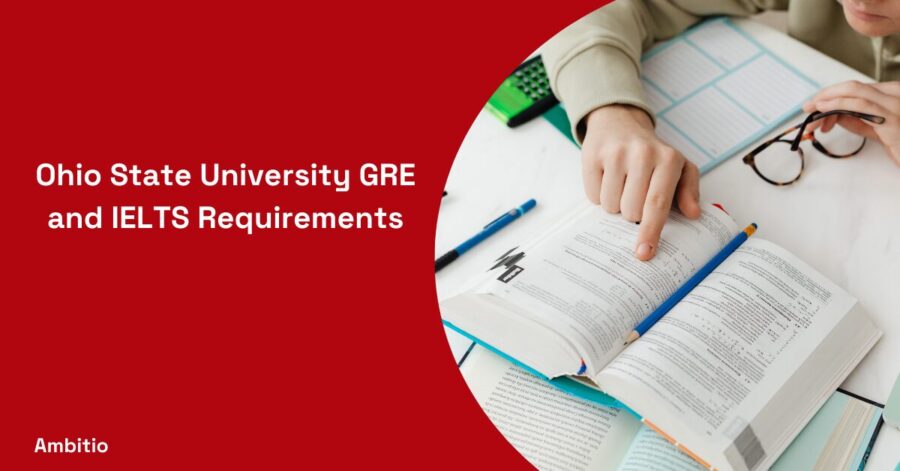22 April 2025
9 minutes read
What Is The Ohio State University GRE and IELTS Requirements For Graduate Admission?

Key Takeaways
- Understand the Ohio State University GRE and IELTS requirements to ensure your application is complete and competitive.
- Test scores like GRE and IELTS are crucial, but some programs may waive them based on your background.
- Keep track of your application status and ensure all required materials, including proof of English proficiency, are submitted.
Over 11,000 students apply to Ohio State University’s graduate and professional programs every year—yet most of them are left guessing when it comes to test scores. If you’re searching for the GRE and IELTS requirements, you’re not alone. Too many official pages leave things vague or buried in academic speak.
It’s frustrating. You spend weeks prepping for the GRE, drop hundreds on test fees, and then hit a wall—some programs require it, some don’t, and nobody tells you clearly. Add to that figuring out where to send your scores (hint: ETS institution code is 1592) and whether a faculty member needs to approve your application—it’s messy. So, let’s clear the air. This blog gives you a straight-up answer on what Ohio State really expects when it comes to GRE and IELTS scores.
What Is The Ohio State University Graduate Admission Process?
It’s not uncommon—many applicants are overwhelmed by the process. Whether you’re an international student or applying as a state student, the application process at OSU can be daunting. Understanding the exact steps and requirements can make the difference between a dream acceptance or a missed opportunity.
The graduate admissions process at Ohio State requires a clear understanding of the application requirements and a focus on details. Here’s a breakdown of the steps to apply for a graduate program at OSU.
Step 1: Complete the Application
The first step in the process is straightforward: complete the application. OSU uses an online portal where you’ll submit all the required application materials, including your personal statement, CV, transcripts, and GRE score (if required). For international students, proof of English proficiency is mandatory—this can be demonstrated through one of the following: TOEFL, IELTS, or even the Duolingo test. Keep in mind, scores are required for fellowship opportunities and may be submitted as part of your complete application.
Step 2: Submit Test Scores
For many programs, score requirements like the GRE or the English proficiency test are essential. Make sure to have your scores sent directly from the educational testing service (ETS), which will help you meet Ohio State’s GRE score and English proficiency expectations. For international applicants, Ohio State generally accepts TOEFL or IELTS scores, and international students from specific countries may be exempt. However, if you are applying to the graduate program at OSU in fields like electrical and computer engineering, some programs may waive the application fee or even the GRE requirement, depending on your academic background and experience.
Step 3: Faculty Advisor and Graduate Teaching Associates
Once your application is in, the next step is critical: finding a faculty advisor. Depending on your program, you might be required to secure a faculty advisor before you can be considered for admission. As a graduate student, you may also be eligible for positions like graduate teaching associates, which not only help you with academic growth but can also provide financial support during your studies. This is a great opportunity to connect with faculty and staff to understand the program’s expectations and get involved in graduate studies early on.
Step 4: Review and Application Status
The application review process is where it all comes together. The graduate admissions office at OSU will evaluate your application based on all submitted materials. For international students, it’s essential to ensure your English proficiency is in line with OSU’s requirements. You can track your application status through the portal to see if any documents or proof of English proficiency are still missing. Once everything is reviewed, you’ll receive an admission decision, which could include a request for an English placement exam or other English test if necessary.
Step 5: Accepting Admission and Preparing for Enrollment
After you’ve been admitted, the final step is to accept your offer and complete your enrollment. Ohio State provides detailed instructions on how to navigate this stage, including registering for classes, obtaining your graduate degree materials, and preparing for your first semester. If you’re an Ohio State student or a new international applicant, make sure you’re aware of all required application materials and have completed any necessary paperwork.
What Is The GRE Score Requirements at Ohio State?
Decoding the GRE Score Expectations
GRE scores are a pivotal part of the application for most graduate programs at Ohio State. While the required score varies by department, a competitive GRE score generally enhances an applicant’s profile.
For instance, programs in STEM fields might require higher quantitative scores, whereas humanities and social sciences might emphasize verbal scores. Understanding these nuances and preparing accordingly can significantly bolster your application.
Strategies for Achieving a Competitive GRE Score
Achieving a competitive GRE score requires a well-planned study strategy. This includes understanding the exam format, identifying your strengths and weaknesses, and practicing with real GRE questions.
Utilizing study guides, taking practice tests, and possibly enrolling in a prep course are effective ways to ensure you are well-prepared. Remember, a high GRE score not only strengthens your application but can also be a deciding factor in securing financial aid or assistantships.
What Is The English Proficiency and the IELTS Requirement?
Understanding the IELTS Criteria for Non-Native Speakers
For non-native English speakers, proving English proficiency is a mandatory component of the application process. Ohio State typically requires a minimum IELTS score of 7.0, although some programs may have higher requirements.
This criterion ensures that all students, regardless of their background, can effectively engage with the coursework, participate in discussions, and complete assignments without language barriers.
Tips for Excelling in the IELTS Exam
To excel in the IELTS exam, a focused preparation plan is essential. Familiarize yourself with the exam’s format, including the types of questions asked in each section (Listening, Reading, Writing, and Speaking).
Regular practice, using authentic IELTS material, and improving your English language skills through reading, writing, and speaking will enhance your chances of achieving a high score. Additionally, consider taking IELTS preparation courses or practice tests to gauge your readiness for the actual exam.
Application Deadline and Required Materials
Navigating the Application Timeline and Deadlines
Meeting application deadlines is crucial in the admission process. These deadlines vary across different departments and programs at Ohio State.
Applicants must ensure they submit their applications and all required materials, such as test scores and transcripts, well before the deadline. Late submissions can lead to missed opportunities or delayed processing, affecting your chances of admission.
Checklist of Required Application Materials
A complete application to Ohio State’s graduate programs typically includes the following: a completed online application form, academic transcripts from all previously attended institutions, GRE scores, English proficiency test scores (IELTS/TOEFL for international students), letters of recommendation, a resume or CV, and a personal statement or statement of purpose.
It’s essential to check the specific requirements of your chosen program, as additional materials like portfolios or research proposals may also be required.
Special Considerations for International Students
Addressing the Unique Challenges Faced by International Applicants
International students face unique challenges in the application process, such as meeting the English proficiency requirement and obtaining student visas.
Ohio State offers various resources and guidance to help international students navigate these challenges effectively. This includes assistance with visa applications, access to English language resources, and orientation programs designed to ease the transition to life in the United States.
Support Services and Resources for International Students
Ohio State provides a range of support services for international students, including the Office of International Affairs, which offers guidance on everything from cultural adjustment to academic advising.
The university also hosts various cultural and social events to help international students integrate into the campus community and foster a sense of belonging.
Exploring Financial Aid and Scholarship Opportunities at OSU
Navigating Financial Aid Options for Graduate Students
Navigating the landscape of financial aid for graduate studies can be challenging. Understanding the different types of aid available and how to access them is crucial for students looking to finance their education at Ohio State University. Here’s a detailed guide on navigating these options:
- Understand the Types of Financial Aid Available:
- Grants and Scholarships: These are essentially ‘free money’ that you do not need to repay. They can be based on merit, financial need, or specific criteria such as field of study or background.
- Loans: Loans are borrowed money that must be repaid with interest. Federal student loans often offer lower interest rates and more flexible repayment options compared to private loans.
- Work-Study Programs: These programs allow you to work part-time while studying, helping you earn money to pay for educational expenses.
- Assistantships: Graduate assistantships provide a stipend and often tuition remission in exchange for part-time work in teaching, research, or administrative roles within the university.
- Grants and Scholarships: These are essentially ‘free money’ that you do not need to repay. They can be based on merit, financial need, or specific criteria such as field of study or background.
- Explore University-Specific Financial Aid:
- Ohio State University offers various scholarships and grants specifically for its students. These could be department-specific or university-wide.
- Check the OSU Office of Student Financial Aid website and the financial aid office of the specific department you are applying to for the most current information.
- Apply for Federal and State Aid:
- Complete the Free Application for Federal Student Aid (FAFSA) to be considered for federal and state financial aid. This can include grants, loans, and work-study opportunities.
- The FAFSA is also used by the university to determine your eligibility for institutional aid.
- Seek Departmental Funding:
- Some departments at Ohio State may have their own funding sources, such as research grants or endowments, that can provide financial support to graduate students.
- Contact the department directly to inquire about available funding and application procedures.
- Look for External Scholarships and Fellowships:
- Numerous organizations, foundations, and professional associations offer scholarships and fellowships to graduate students. These can be based on academic merit, research interests, or other criteria.
- Regularly search databases and resources like Fastweb, the National Science Foundation, and professional association websites relevant to your field of study.
- Understand Loan Options and Repayment:
- If you need to take out loans, understand the different types, including federal subsidized, unsubsidized, and PLUS loans, as well as private loans.
- Educate yourself about repayment terms, deferment options, and potential loan forgiveness programs.
- Consider Work-Study or Part-Time Employment:
- The Federal Work-Study program provides part-time jobs for graduate students with financial needs, allowing them to earn money to help pay education expenses.
- Additionally, consider part-time employment opportunities on or off-campus.
- Stay Informed and Meet Deadlines:
- Financial aid often operates on strict deadlines. Make sure you are aware of and meet all application deadlines.
- Keep up to date with any changes in financial aid policies, amounts, or requirements.
- Consult with Financial Aid Advisors:
- Ohio State University’s financial aid advisors can provide valuable guidance and help you navigate the complexities of financial aid.
- They can assist you in understanding your financial aid package, exploring additional funding options, and managing loan responsibilities.
- Review and Compare Offers:
- If you receive multiple financial aid offers, compare them to understand which is the most beneficial. Consider factors like the amount of free money (scholarships/grants) versus loans, and the nature of assistantship duties.
- Plan for the Long Term:
- Consider the long-term implications of your financial choices, particularly when taking out loans. Budget wisely and consider the impact of your financial decisions on your life post-graduation.
By thoroughly exploring these avenues and carefully planning your finances, you can effectively navigate the financial aid options available for graduate studies at Ohio State University.
This proactive approach will not only help ease the financial burden of your education but also allow you to focus more on your academic and professional goals.
Tips for Securing Scholarships and Assistantships
Securing scholarships and assistantships is a vital step for many students in financing their graduate studies. Here are some effective strategies to increase your chances of securing these financial aids:
- Start Early: Begin your search for scholarships and assistantships well in advance. This gives you ample time to prepare your applications and meet deadlines.
- Research Thoroughly: Investigate all available financial aid options offered by Ohio State University. Check departmental websites, university financial aid offices, and external funding sources.
- Tailor Your Application: Customize your application to align with the specific requirements of each scholarship or assistantship. Highlight relevant experiences, skills, and academic achievements.
- Showcase Academic Excellence: Maintain a strong academic record. High grades, research projects, publications, and academic honors can significantly strengthen your application.
- Gain Relevant Experience: Participate in research projects, internships, or volunteer work related to your field of study. This experience can make you a more attractive candidate for assistantships.
- Develop Strong Relationships with Faculty: Establish good relationships with your professors and advisors. Their recommendations can be crucial in securing assistantships and scholarships.
- Write a Compelling Personal Statement: Your personal statement should clearly articulate your goals, interests, and qualifications. Make a compelling case for why you deserve the scholarship or assistantship.
- Prepare for Interviews: Some scholarships and assistantships require interviews. Practice your interviewing skills and be prepared to discuss your academic interests, experience, and future plans.
- Apply Broadly: Don’t limit your applications to just a few opportunities. The more scholarships and assistantships you apply for, the greater your chances of securing financial aid.
- Meet All Application Requirements: Ensure that you meet all eligibility criteria and submit all required documents. Pay attention to details like word limits, formatting guidelines, and deadlines.
- Follow-Up: After submitting your application, it’s appropriate to follow up if you haven’t heard back by the expected time. A polite inquiry demonstrates your continued interest.
- Network with Current Graduate Students: Connect with current students who have successfully secured scholarships or assistantships. They can provide valuable insights and advice on the application process.
- Highlight Extracurricular Involvement: Showcase any leadership roles, community service, or extracurricular activities that demonstrate your well-roundedness and commitment to your field.
- Seek Feedback on Applications: Have mentors, advisors, or peers review your applications and provide feedback. Constructive criticism can help you improve your application.
- Stay Informed about Deadlines and Updates: Regularly check for any updates or changes in application deadlines, requirements, or procedures. Staying informed ensures that you don’t miss out on any opportunities due to oversight.
By following these tips, you can enhance your profile and increase your chances of securing scholarships and assistantships at Ohio State University. Remember, persistence and a well-prepared application are key to success in this competitive process.
Conclusion
Gaining admission to a graduate program at Ohio State University requires careful preparation and a thorough understanding of the application requirements, particularly GRE and IELTS scores.
By meticulously preparing for these components and utilizing the resources and support available, applicants can significantly enhance their chances of joining this esteemed institution and thriving in their academic and professional endeavors.
FAQs
What is the minimum GRE score required for admission?
The minimum GRE score varies by program. Applicants should check the specific requirements of their chosen department.
Is the GRE score mandatory for all graduate programs?
Most programs require the GRE, but some may offer waivers or exceptions. It’s essential to check the program-specific requirements.
Can the IELTS score be substituted with another English proficiency test?
Yes, OSU also accepts TOEFL scores. Some programs may accept other tests like the Duolingo English Test.
Are there application fee waivers available?
Fee waivers are available under certain conditions, such as for applicants with financial hardships.
How can international students check their application status?
Application status can be monitored through the online application portal.

You can study at top universities worldwide!
Get expert tips and tricks to get into top universities with a free expert session.
Book Your Free 30-Minute Session Now! Book a call now




























